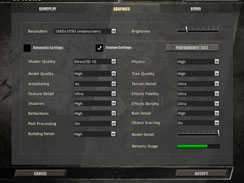Company of Heroes: Opposing Fronts
Publisher: THQWe used the full retail version of Company of Heroes: Opposing Fronts patched to version 2.1.0.3. It's the expansion pack for one of the best real-time strategy games of all time. Not only is the gameplay incredibly good and immersive, the graphics engine is simply stunning, making extensive use of post processing and advanced lighting techniques in the fully destructible environment.
The original game was updated to version 1.7.0 in June, and that patch brought DirectX 10 capabilities to the game's engine. We've compared the various DirectX 10 cards using the game's DirectX 10 mode and Opposing Fronts expands on the original's DirectX 10 features.
For our testing, we used the in-built demo to gauge performance, which is very similar to the original rolling demo, but with some new effects. In this rolling demo, there is heavy use of water, lighting, explosions and also masses of vegetation and it represents fairly typical performance throughout the game.
The in-game details were set to their maximum values, with anti-aliasing controlled from inside the game - we've included a screenshot of the settings used below. Anisotropic filtering was forced from the driver control panel in all cases.
Opposing Fronts is a game that shows up the Radeon’s poor anti-aliasing performance pretty well because despite the 17 percent performance deficit at 1680x1050 0xAA 16xAF, the game is perfectly playable on both the Radeon HD 3870 and GeForce 8800 GT cards. What’s disappointing though is that the GeForce 8800 GT remains very playable at 1680x1050 4xAA 16xAF whilst the Radeon HD 3870 does not – the performance gap increases to 32 percent.
As the resolution increases to 1920x1200, the two are both playable with 0xAA 16xAF with the GeForce 8800 GT having a 13 percent performance advantage, but neither is really playable when 4xAA is applied. What’s interesting here though is that the GeForce 8800 GT’s anti-aliasing performance appears to not be as good as it is at 1680x1050, as the Radeon HD 3870’s performance deficit at the higher resolution is just 14 percent.
This could be down to RV670 making more efficient use of the bandwidth available to it as an increasing amount of strain is put on the GPU. The reason I say this is because, if you look at the GeForce 8800 GTS 640MB’s performance pattern, it performs better than you would expect it to with anti-aliasing enabled at 1920x1200 because performance (in relative terms) with anti-aliasing disabled, is quite low.

MSI MPG Velox 100R Chassis Review
October 14 2021 | 15:04











Want to comment? Please log in.